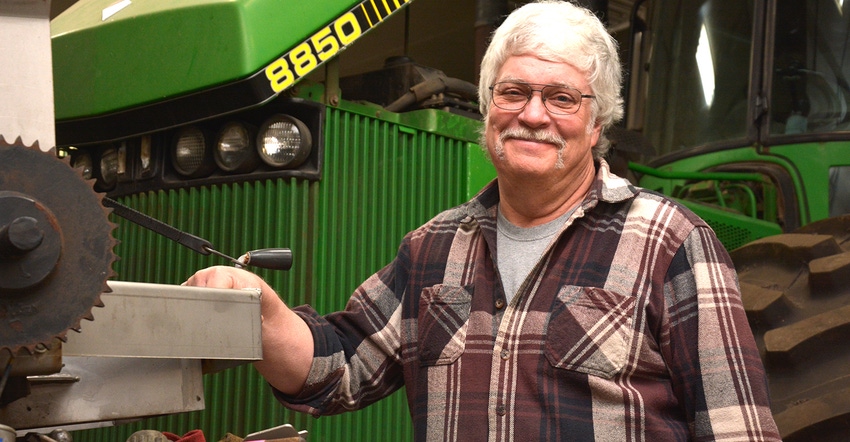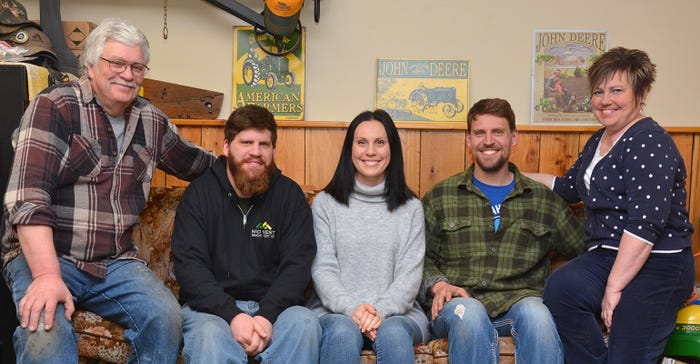
Even after farming for 42 years and following no-tilling practices for a decade, John Peterson continues to learn about his soils and the impact of his crop management.
The North Branch, Minn., farmer volunteered to spend six crop seasons working with Discovery Farms Minnesota, allowing the organization’s staff to install monitoring equipment at the edge of a no-till field to gather year-round water quality data.
Peterson farms 2,500 owned and rented acres in corn and soybean rotation with his wife Jewell, daughter Natasha Wikelius, and sons Nate and Nic. Their operation, Spring Creek Farms, was one of the first farms — and the only no-till farm — to partner with Discovery Farms when it began in 2010.

TEAM EFFORT: Peterson family members actively involved at Spring Creek Farms, North Branch, Minn., are (from left) John, Nic, Natasha Wikelius, Nate (“Sonny”) and Jewell. As their adult children returned to the farm, John and wife Jewell have seen them assume jobs that fit their skill sets. Natasha does grain marketing and fills in where needed from planting through harvest; Nate plants and harvests soybeans and runs the corn dryer; and Nic overhauls the corn planter every year, helps with tillage, and spreads fertilizer and disks in the fall.

“I was interested in finding out about our style of farming and its impact,” Peterson says. “The public talks about how farmers don’t take care of our soil and water. With Discovery Farms, we would have documentation to show if we were doing things right — and how to improve.”
Spring Creek Farms is close to the St. Croix River and operates in the Sunrise River watershed. Peterson already had been working with the Chisago Soil and Water Conservation District to implement practices to protect his area natural resources. In 2002, the farm was honored with a county SWCD outstanding conservationist award.
For the Discovery Farms project, a 6-acre site of well-drained Cushing loam soil with an average slope of 3.4% was chosen for monitoring. Equipment was installed on the west end of an alfalfa waterway to record precipitation, temperature and surface water runoff. Corn was planted around the monitoring site in 2011, 2013 and 2015; soybeans in 2012, 2014 and 2016.
What he learned
Peterson’s no-till, along with additional conservation practices, continue to minimize erosion and keep soil in place. With the St. Croix just over 2 miles away, the landscape rolls in all directions.
“It was interesting to see how little soil is leaving the farm, compared to tillage systems,” he says. “We used to have erosion in fields as deep as I am tall.”
One effective practice Peterson has found is to plant fields in rows of 40 feet of corn and 40 feet of soybeans. The family has planted up to 1,000 acres in a season this way.
“The erosion control with this is second to none,” he adds. Plus, with the strips, they’ve observed a couple of interesting side benefits. On the soybean strips, snow melts seven to 10 days before the snow on corn strips, thus the ground thaws and dries sooner. And to gauge yield on cornfield strips, they hand-picked, shelled and weighed 411 bushels of corn on the east and west sides of the strips.
“We found you can have up to 18 bushels more on the west side of corn rows,” he says. “The sun makes a big difference.” He adds that the fields picked were planted with the same corn and managed the same way.
Peterson likes how no-till continues to improve soil health and structure, too.
“When you no-till, you find out how much life is in the soil,” he says. After it rains, you can actually hear the ground gurgling, as the rain seeps into worm channels.
“When you’ve got that, you’ve got it made,” he adds. “The ground breathes.”
The specifics
Some of the data collected by Discovery Farms staff at Spring Creek Farms over a six-year period show:
• Soil loss ranged from 12 to 142 pounds per acre, with a median loss of 69 pounds — equivalent to a 5-gallon pail of soil lost from a football-sized field. That compares to a median 260-pound-per-acre loss on other Discovery Farms participants. On Peterson’s farm, 85% of the soil loss occurred in April, May and June.
• Annual surface runoff was higher, compared to other Discovery Farms participants — 3.5 inches versus nearly 2 inches. More than half of that runoff occurred at Spring Creek, when soils were frozen in February, March and April. Rainfall was below normal for three years, near normal one year and above normal for two years at the farm.
Discovery Farm staff note that precipitation levels did not correlate to surface runoff. Case in point: February and March contributed 42% of the annual runoff and saw only 8% of the annual precipitation. And two-thirds of the annual rain occurred from May through September, with less than one-third of the annual runoff. Obviously, runoff was limited by growing crops.
• Nitrogen fertilizer losses in surface water runoff, on average, were lower for Spring Creek compared to other Discovery Farm sites — except on June 21, 2013.
“We put on N that day, and in a couple of hours we had a torrential rain,” Peterson recalls. “We were bulk-spreading N in one pass at the time, and corn was close to knee-high.”
Monitoring data picked up on that and recorded N loss at eight times higher that day.
“That helped us change our minds and decide to start split-applying N,” Peterson adds. The family modified both its tractor and fertilizer spreader to ride higher than the corn. Plus, the Petersons widened the tractor wheel stance so both the tractor and spreader ride in the same wheel track. They apply their first application of N when corn is 10 to 12 inches tall. The second application goes on as late as possible — when corn is around 3 feet tall, or waist-high.
• The range of total phosphorus loss was similar to other Discovery Farms sites. Yet dissolved P loss at Spring Creek was higher, with an annual rate of 0.56 pound per acre lost, versus 0.29 pound per acre. Discovery Farms staff note that higher residue levels and stratified soil P in no-till systems leads to higher dissolved-P losses.
Banding P fertilizer, which Peterson is now doing, will help reduce that number. He had been broadcasting phosphorus and potassium before planting his no-till corn. Several years ago, he switched to banding in P and K, and planting the seed about 1.5 inches above the fertilizer.
Overall, serving as a Discovery Farm was a good experience for Peterson.
“Everything fell into place with what we were doing and learning,” he adds.
About the Author(s)
You May Also Like






